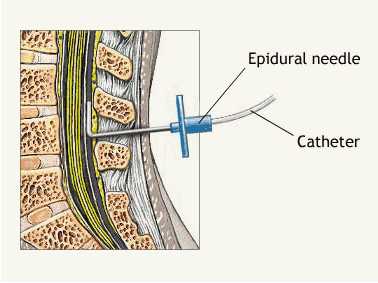| Public Awareness - PAIN RELIEF IN LABOUR |
Pages
|
During labour, pain impulses from the uterus, cervix and the structures of the birth canal pass through the sympathetic nerves and the peripheral nerves into the spinal cord and ascend to the higher centres in the brain where they are perceived as labour pains
In Neuraxial blocks we use some drugs at the level of spinal cord which block this transmission of pain impulses to the brain so that even in the presence of uterine contractions the mother does not feel the pain. So, LABOUR PAINS and Uterine Contractions are not synonymous and it is only the uterine contractions that are essential for the birth of the child and not the Labour pains.
|
|
||||||
Epidural block is given in the lower back. You will either be sitting up or lying on your side. The block is administered below the level where the spinal cord ends (below L1). This is called Lumbar Epidural Block. The block can also be given in tail bone area. This is called the Caudal Epidural Block.
Before the block is performed the patients skin will be cleaned with an antiseptic solution (eg: Povidone Iodine). The Anaesthesiologist uses a local anaesthetic to numb an area of your lower back. A special needle (Toughy needle) is placed in the epidural space which is just outside the spinal sac. A tiny flexible tube called the Epidural Catheter is inserted through this needle. Occasionally, the catheter will touch a nerve, causing a brief tingling sensation down the leg.

Once the catheter is positioned properly the needle is removed and the catheter is taped in place. A local anaesthetic and a narcotic mixture as decided by your Anaesthesiologist is injected into the epidural space through this catheter. Additional doses can also be given through this same catheter without another needle being inserted.
|
||||||
|
||||||
Pages
|